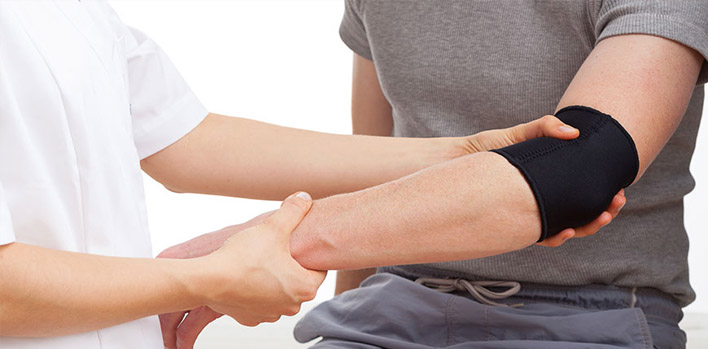Tennisist Elbow
Friday, July 28, 2017 | Healthy lifestyle
LATERAL EPİKONDİLİT / LATERAL EPICONIDITY
The most common pain problem in elbow area is tennisist elbow. It occurs after repeated wrist movements such as screw tightening, jar opening, heavy lifting. Movement of the hand and wrist to the back of the hand, overtightening of the hand or held material, spinning movements with squeezing are seen after repeated application. The origin of the muscles that make this movement in the wrist is the protruding region and the front of the outer side of the elbow. There is a decrease in the vascularity due to continuous use in the structure of the muscles, the adhesion site in this region. This has been shown to lead to inadequate oxygenation and consequent thickening with deterioration.
Disease can be seen in different forms ranging from mild pain in the elbow area to pain in which the hand can not be used in certain movements. Do not press the outside of the elbow with your finger, sometimes the touch is painful. Can not remove weights such as glasses, teapots. At the beginning, mild swelling may occur. When the elbow is in a twisted position, the wrist is pointed at the base while the wrist is lifted up against the cape is often painful. Your middle finger; Force against the perspiration in the open position again leads to pain. The elbow increases the pain by lifting the weight (like lifting the chair) or stretching while the thumb is in the side of the body in the straight position.
There is often a strain or overuse story before the pain. If recurrent use or coercion is temporary, these findings may disappear after a while. However, as they usually continue to do the same work, the pain becomes chronic and constant.
Diagnosis
Diagnosis is usually easy. The film, MR or lab is not required at the start. However, if there is no improvement after 6 weeks of treatment, an elbow 2-way film may be taken with differential diagnosis. Ultrasound or MR can be removed to distinguish whether intra-articular or other joint disturbances are present.
Treatment
In the treatment, made recommendations on the restrictions on the use of hand and hand-wrist. Hand wrist and hand movements; It is regulated so that the muscle group caught by the disease is rested. Drug therapy is regulated. The gel applied to the painful region and the oral rheumatologic drug treatment are drugs used in the first step.
If these measures do not improve, an elbow band, called epipoint, can be used. The purpose of this band is; This muscle group, when contracted, not from the painful region of the elbow, but from the painful region, down from the band applied on the muscle, to listen to the painful region. Wrist wristlets can be used on painful tablets spreading from the elbow to the wrist.
Defined exercises are not performed during the acute period and exercises are used during the healing period. At this stage, usually with mild form improved, they have become, at least when the pain does not strain. In moderate and severe forms, this treatment is answered but it is inadequate, the pain persists, it is difficult to use the hand. Since pain is often on the dominant hand side (left side on the left), that is, on the frequently used side, the hand remains in daily life. This causes the pain to continue.
Regional injection
These patients are in pain or condition through patient then repeated, this time can be different applications. Physical therapy is applied. Applications such as cortisone injection, PRP injection, hyaluronate injection are performed in the painful region. In the short term, pain and complaints in the 6-8 week period are the most effective method of injecting regional cortisone. However, long-term comparative results of cortisone injection are not at expected levels compared to other methods. PRP injection (the patient's own platelets) can be performed. There are reports that long-term results are more satisfactory than cortisone administration. Hyaluronate injections are also drugs used in practice. The patient's own blood can be administered to the painful area with a local anesthetic drug.
Dry needle or saline / sugar water injection (prolotherapy), local anesthetic drug injection applications are available. Local injection and dry needle application is done to several points rather than single point. There are publications that suggest bleeding and tissue factors associated with needle-point irritation during this procedure are improving.
Other treatment methods
It has been reported that pulsed ultrasonic sound wave ESWT applications (work done with the application of the stone breaking device to the muscle tissue) do not have good results at the expected level. It may be among the treatment alternatives, not the more preferred methods because they are painful.
Among the results, there is no method yet to be definitive in the treatment of each patient. If the results are not obtained from the treatments, the operation can be planned.
Surgery is rarely necessary in a tennis player's elbow. As occupational diseases, those who have to use the hand in the same way constantly are those who are resistant to treatment; It is researched whether the intra-articular disorders are accompanied by MR. In these cases angio-fibroblastic tissue (diseased tissue) is surgically removed. The attachment of the short of the triple muscle group adhering here is liberated. Subsequent physical therapy will bring the muscles back to normal strength and normal joint movements.
Keywords: Tennisist elbow, lateral epicondylitis, elbow pain, epicondylitis, tendonitis, tendinopathy, tendon, tendon disease, forearm pain, arm pain, elbow swelling, prp, prp injection, cortisone, cortisone injection, cortisone needle, dry needle.
Dr. Cuma KILIÇKAP












